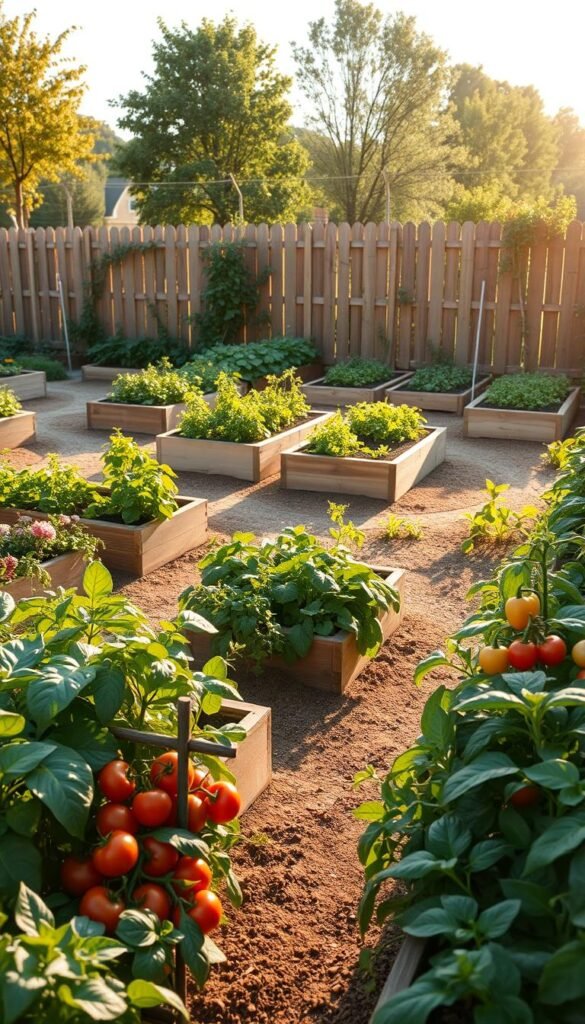Imagine stepping outside to pick fresh ingredients for tonight’s dinner—right from your own backyard. Creating a productive growing space isn’t about finding a one-size-fits-all solution. As horticulturist Steven Biggs explains, two gardeners can transform the same plot into entirely different layouts that each thrive. Your ideal setup depends on sunlight, soil quality, and even how much time you want to spend tending plants.
Whether you’re working with a balcony or a half-acre lot, smart planning makes all the difference. Start by observing sunlight patterns: most crops need 6-8 hours daily. Experts recommend placing beds near your home’s entrance for easy access. Keep beds narrow (3-4 feet wide) so you can reach plants without compacting soil.
Spacing matters more than you might think. For example, tomatoes yield 40% more fruit when given proper room. Techniques like square foot gardening pack plants efficiently—growing 16 carrots or 9 bush beans in one square foot. Pair this with raised beds filled with nutrient-rich soil, and you’ll harvest five times more than traditional row planting.
Your outdoor space should reflect your lifestyle. Maybe you want low-maintenance perennials or a colorful mix of herbs and flowers. The key? Balance creativity with practical steps like drip irrigation to save water. With thoughtful design, you’ll enjoy fresh flavors all season long—no grocery store required.
Welcome to Your Home Vegetable Garden Journey
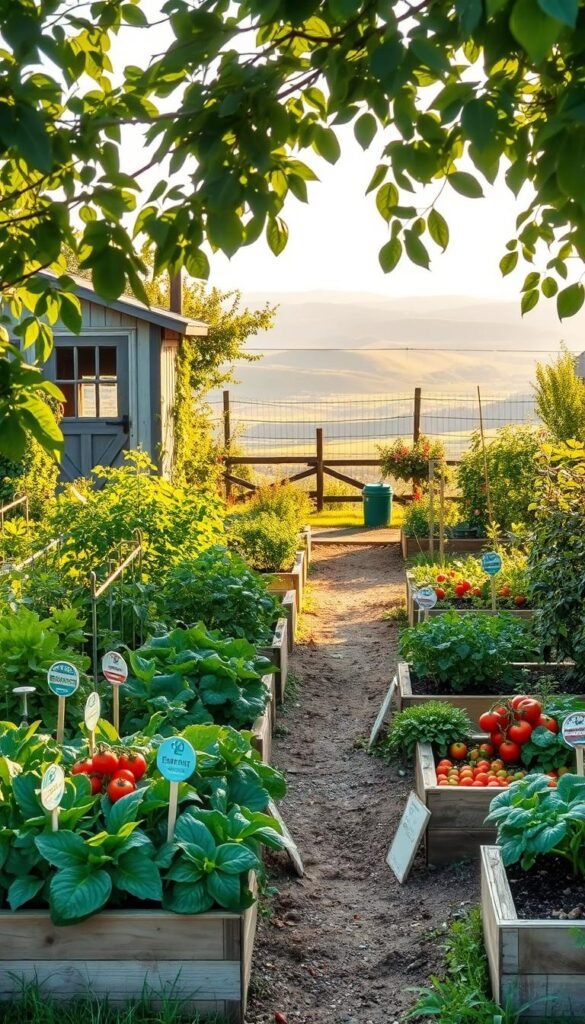
There’s nothing quite like biting into a sun-warmed tomato you’ve grown yourself—flavors bursting with life that store shelves can’t match. This adventure lets you transform seeds into meals while reconnecting with nature’s rhythms. Whether you’re planting in pots or plots, every harvest becomes a personal victory.
Successful growing blends creativity with science. You’ll learn to read sunlight patterns like a clock and feel soil texture through your fingers. Three essentials separate thriving plants from struggling ones: proper spacing, nutrient balance, and consistent watering.
Consider these rewards awaiting you:
- 20% more antioxidants in homegrown greens compared to store-bought
- 30 minutes of gardening burns 150 calories
- 65% reduction in food waste when picking only what you need
| Aspect | Store-Bought | Homegrown |
|---|---|---|
| Nutrients | Declines during transport | Peak freshness at harvest |
| Flavor | Standardized taste | Tailored to your palate |
| Cost | $2.50/lb tomatoes | $0.30/lb after setup |
Your climate and available space will shape this journey uniquely. Urban growers might train beans up balcony rails, while suburbanites could rotate crops across raised beds. Remember: Every seasoned gardener once planted their first seed—yours could sprout tomorrow.
Home Vegetable Garden Design: Practical Layouts for Homegrown Produce
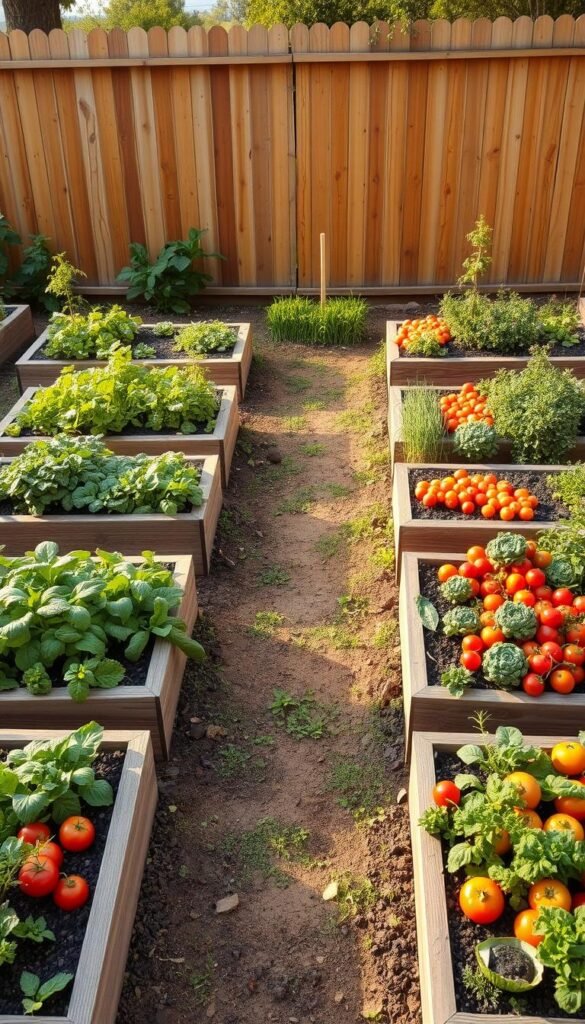
What separates a thriving plot from a struggling one? It starts with smart arrangement. Your growing space becomes more productive when you balance sunlight exposure, water flow, and plant relationships. Three rules apply: group crops by needs, leave room for growth, and position taller plants where they won’t shade others.
Traditional rows work for large spaces, but compact areas shine with layered designs. Try pairing deep-rooted carrots with shallow lettuce—they’ll share soil without competing. Research shows staggered planting boosts yields by 19% compared to straight lines.
Consider these tested approaches:
| Method | Best For | Yield Boost |
|---|---|---|
| Traditional Rows | Large plots, easy harvesting | Baseline |
| Raised Beds | Poor soil areas | 35% more |
| Square Foot | Small spaces | 5x density |
Air circulation prevents disease—space plants so leaves don’t touch when mature. Drip systems save 40% more water than sprinklers while keeping leaves dry. Rotate crops yearly to keep soil nutrients balanced.
Your layout should evolve as you learn. Track which arrangements produce the healthiest greens or juiciest tomatoes. That’s the beauty—your edible landscape becomes uniquely yours, season after season.
Exploring Various Vegetable Garden Layout Options
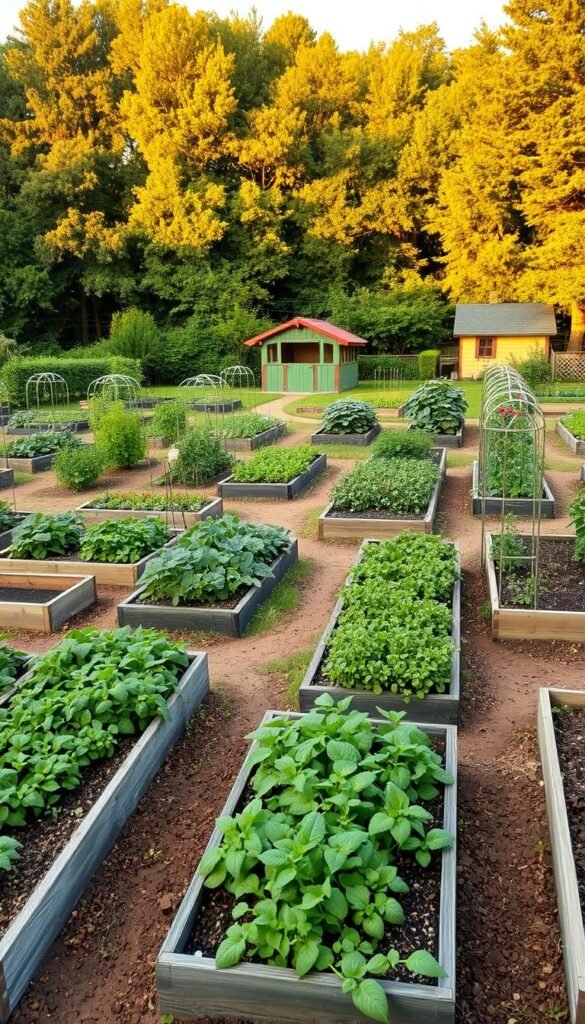
Your garden’s success starts with choosing the right foundation. Three main approaches dominate modern growing: in-ground plots, elevated raised beds, and portable containers. Each method shines in specific scenarios, letting you match your setup to available space and personal needs.
Soil to Sky: Matching Methods to Your Space
Traditional in-ground planting works best for sprawling crops like corn or potatoes. These vegetables develop deep roots that thrive in open earth. For tighter areas, square-foot gardening packs 16 carrot plants or 4 kale heads per square—ideal for urban patios.
Flexible Solutions for Every Lifestyle
Raised beds solve drainage issues and reduce bending—perfect for seniors or clay-heavy soil. Containers let renters grow tomatoes on fire escapes or herbs near sunny windows. Studies show movable planters extend growing seasons by 3 weeks through strategic sun chasing.
| Method | Best Use | Key Benefit |
|---|---|---|
| In-Ground | Large root crops | Lowest upfront cost |
| Raised Beds | Poor drainage areas | Warmer soil, fewer weeds |
| Containers | Limited space | Full environment control |
Combine methods for hybrid systems—maybe raised beds for greens and containers for peppers. Track what works through seasons. Your perfect garden layout emerges through experimentation, not rulebooks.
Embracing Raised Bed Gardening for Optimal Growth
Picture a garden that adapts to your land’s quirks instead of fighting them. Raised beds turn problem areas into productive spaces—whether you’re dealing with rocky ground or poor drainage. These elevated systems let you craft ideal conditions for roots to thrive, no matter what lies beneath.
Advantages of Raised Beds for Vegetable Gardening
Why do growers love these setups? Control. You mix custom soil blends—potting mix, compost, and organic matter—to create a nutrient buffet. Unlike stubborn clay or sandy earth, your plants get perfect drainage and airflow. Research shows crops in raised beds grow 20% faster due to warmer, looser soil.
Struggling with limited mobility? Build taller frames to tend greens without bending. One study found gardeners using waist-high beds reduced back strain by 73%. Even wheelchair users can harvest peppers at eye level with properly designed platforms.
| Feature | Raised Beds | In-Ground |
|---|---|---|
| Soil Quality | Customizable | Native Only |
| Accessibility | Adjustable Height | Ground Level |
| Yield Potential | 35% Higher | Baseline |
Start small with a 4×4 frame using cedar planks or bricks. As confidence grows, expand your system. Need guidance? This step-by-step raised bed tutorial walks through construction basics. You’ll soon enjoy fewer weeds, easier pest control, and harvests that outpace traditional plots.
Vertical Gardening: Maximizing Your Growing Space
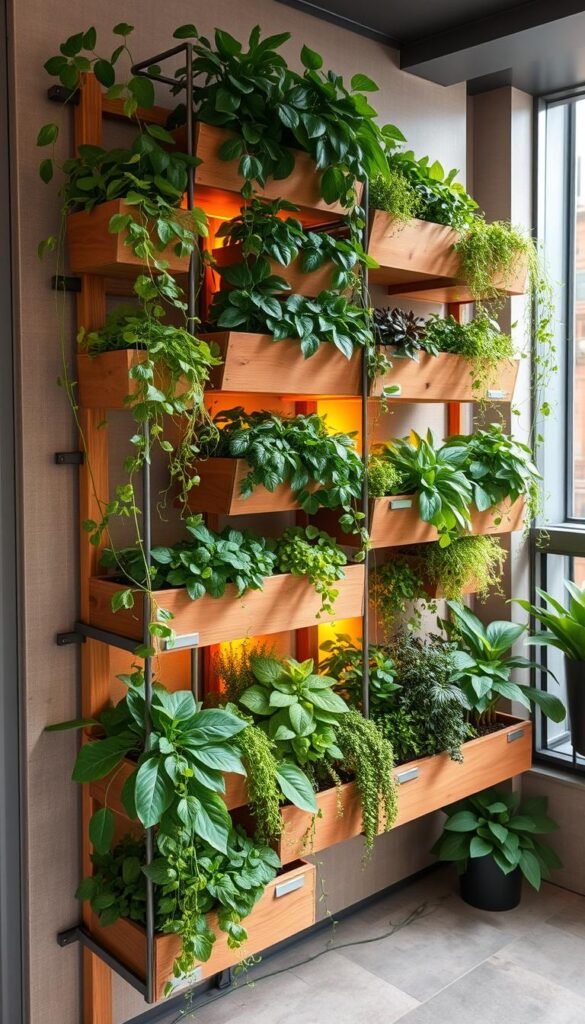
What if your garden could grow upward instead of outward? By training climbing plants to reach for the sky, you unlock 3D growing potential. This method turns blank walls, fences, and unused airspace into lush edible displays.
Implementing Trellises and A-Frames
Simple structures transform limited ground space into layered ecosystems. A bamboo-and-wire A-frame supports heavy squash vines while shading lettuce below. For small areas, try DIY trellis projects using recycled materials—old ladders or pallets work perfectly.
Ideal Crops for Climbing and Hanging Systems
Choose vigorous growers that thrive with vertical support:
- Malabar spinach (heat-tolerant leafy green)
- Pole beans (produce 3x more than bush varieties)
- Achocha (Bolivian cucumber with crunchy fruits)
Steven Biggs recommends pairing vining peas with cucumbers—their growth cycles complement each other. Vertical systems boost airflow, cutting disease risks by 40% compared to ground-level planting. Plus, harvesting at eye level saves your back!
Even sun-starved balconies become productive when you think vertically. Hang strawberry planters above railing boxes of herbs. Train tomatoes up twine grids. Every upward inch multiplies your harvests without expanding your footprint.
Block Versus Row Planting: Maximizing Density and Efficiency
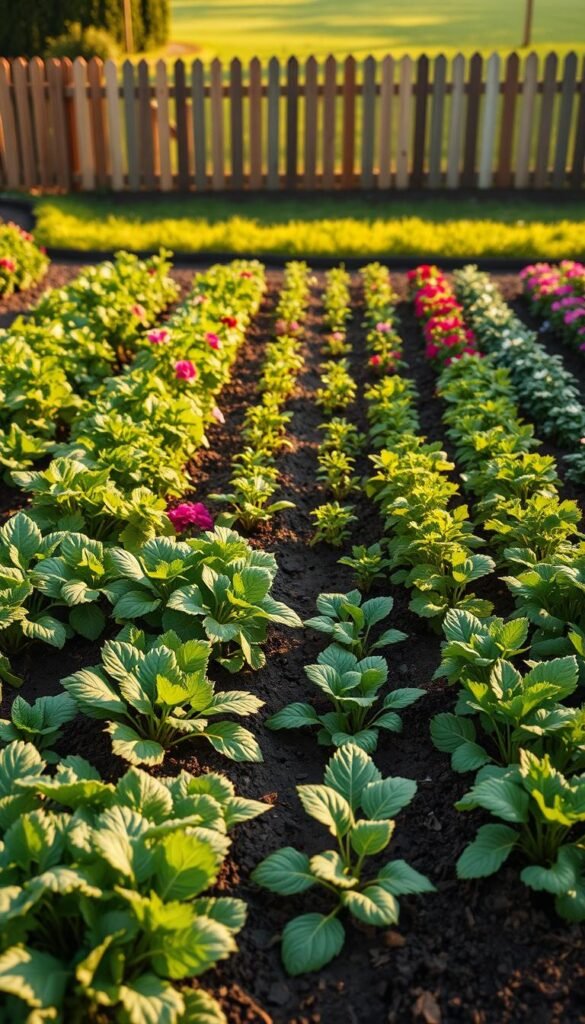
Picture your harvest doubling without expanding your plot—just by rearranging how you place seeds. Horticulturist Steven Biggs champions block planting over traditional rows for small-scale growers. “Farmers need tractor access, but you need every inch to count,” he notes. This approach packs crops tightly, turning bare soil into lush edible patches.
Block setups work magic with root vegetables and leafy greens. Scatter carrot seeds across a 1×1-foot area instead of single-file lines—you’ll thin young plants for snacks while others mature. Garlic bulbs thrive shoulder-to-shoulder, their leaves forming a living mulch that smothers weeds naturally.
Some crops still prefer personal space. Tomatoes demand room for cages, while potato hills need loose soil mounded around stems. Pole beans climb best when given vertical support in organized lines. Match your layout to each plant’s personality:
| Method | Best For | Benefits |
|---|---|---|
| Block Planting | Beets, spinach, garlic | 40% less weeding |
| Row Planting | Tomatoes, peas, potatoes | Easy maintenance |
Dense planting isn’t just about quantity—it creates microclimates. Tightly spaced lettuce leaves cool the soil, while staggered broccoli heads block pests’ sightlines. Leave 18-inch walkways between blocks for harvesting access without compacting growing zones.
Test both methods in your space. Start a block of rainbow chard beside trellised cucumbers. You’ll quickly see which plants flourish in community living versus those needing elbow room.
Companion Planting Strategies for a Healthier Garden
Transform your plot into a thriving ecosystem where plants work together like old friends. This approach goes beyond simple spacing—it’s about creating partnerships that boost yields naturally. Companion planting lets you harness nature’s teamwork while reducing pest issues and soil fatigue.
Smart Pairings for Efficient Growth
Try Steven Biggs’ favorite trick: scatter radish seeds among carrots. The radishes sprout fast, marking rows while loosening soil. By harvest time, your carrot seedlings gain space as you pluck peppery roots for salads. This tag-team strategy works with beets too—quick growers prep the stage for slower performers.
Proven Partnerships That Deliver Results
Science shows certain duos outperform solo plants. Basil planted near tomatoes cuts pest damage by 35% while enhancing flavor. Corn stalks become living trellises for beans, which repay the favor by fixing nitrogen in soil. These companion strategies turn your space into a self-supporting network.
Experiment with combinations that suit your climate and palate. Whether you’re growing crisp beans or aromatic herbs, smart planting partnerships make every square foot work harder. Your harvests will taste sweeter knowing nature’s doing half the work!

